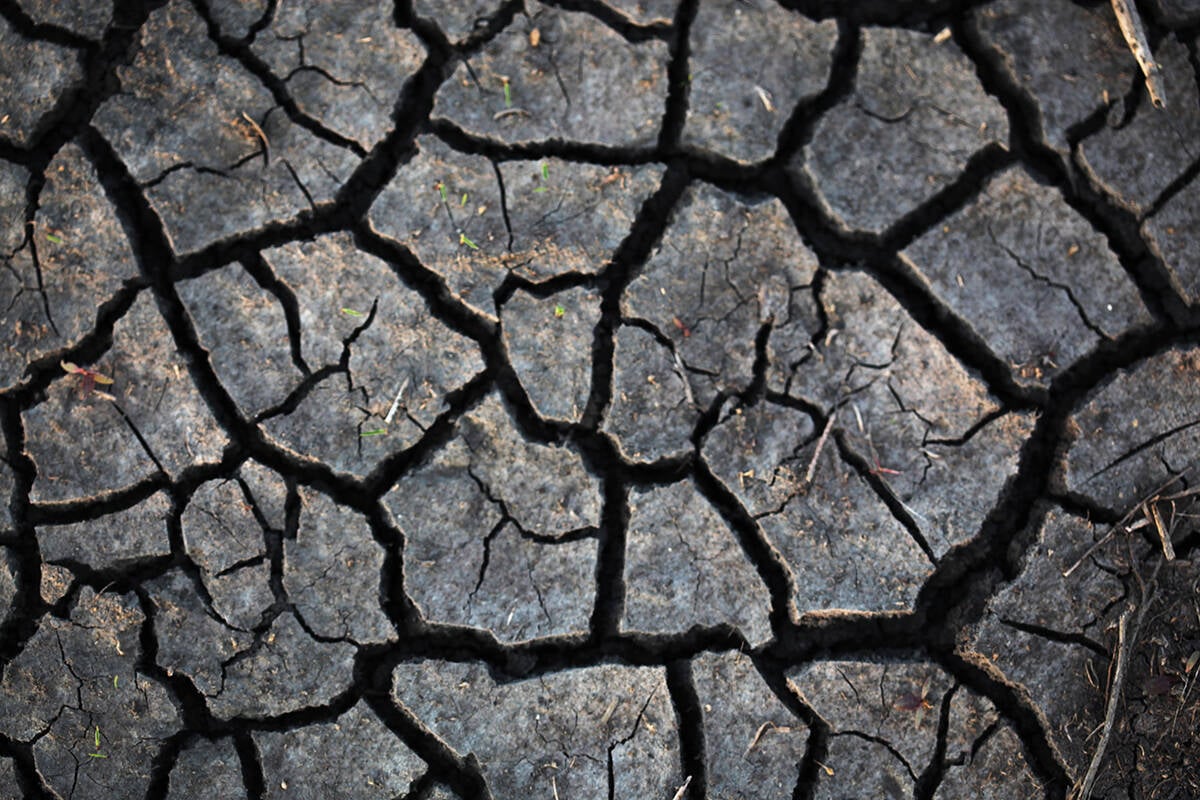There are certain guarantees that come with living on the Prairies.
One of the most definitive is drought. It affects the landscape, the economy and, in many cases, livelihoods.
“The prairie natural region, the Prairies, is defined by the repeated occurrence of drought that prevents trees from surviving in this climate,” says Dave Sauchyn, a University of Regina geography professor who works from the Prairie Adaptation Research Collaborative.
“No place else in Canada is defined in terms of drought like that.”
Droughts have been part of the prairie climate since long before the region’s first settlers.
Read Also

Prairies have variable soil moisture conditions
The dry weather in the west was welcome for preserving grain quality and advancing harvest, but it has resulted in very dry soil moisture conditions.
About 6,000 years ago, the region received so little moisture that water basins such as the one at Lake Manitoba dried up.
In the 1790s, the soil was dry enough that the dunes began moving in the Great Sand Hills of southwestern Saskatchewan. This drought was also severe enough that the North Saskatchewan River didn’t have enough water in some places to float a canoe.
A drought from the late 1840s to the early 1860s was severe enough to convince John Palliser, a geographer and explorer, that much of the region was unsuitable for development.
These drought periods, among others, have been enough to convince many researchers that recent generations haven’t experienced a truly bad prairie drought.
“That’s where we think that we, being the nonaboriginal population, haven’t been here long enough to see how bad droughts can really get,” Sauchyn said.
“The longer you go back, the more likely you are to find droughts that are quite a bit worse than the ones that we’ve seen.”
The period covering the past 120 years, particularly from the late 1890s to early 1900s, is considered to be the second wettest period discovered in prairie history so far. The wettest was approximately 1,200 years ago, from 700 to 900 AD.
“That’s not to say that every year has been wet in that period, it’s just that in the past it seems that it was more often drier than wetter and now it’s more often wetter than drier,” said Peter Leavitt, a U of R biology professor and Canada Research Chair.
The past century has also had its dry periods, one of the most significant being the Dirty Thirties.
“Of the last 100, 120 years, certainly the 1920s and ’30s were the longest period of drought,” Sauchyn said.
It occurred from 1929 to 1938, with the severest years being 1936-38. At times the drought affected virtually all of the Palliser Triangle, an area covering most of the southern Prairies.
The lack of precipitation and frequency of high winds led to dust storms throughout the area, and the lack of moisture eventually led to near starvation conditions.
The severity of this drought prompted many farm families to leave, reversing the population flow for the first time since European immigration began in the 1870s.
The government responded with policies and programs such as the Prairie Farm Rehabilitation Administration, which were intended to rehabilitate soil and farms, assist people living in drought-affected regions and sometimes relocate people to more promising locations.
Although the drought of the 1930s cost the federal and provincial governments significant amounts of money – almost $175 million was provided for rural relief in Saskatchewan – the most expensive drought on record, according to Environment Canada, was that of 2001-02, which affected British Columbia, the Prairies, Ontario, Quebec and Nova Scotia and cost the country $5 billion.
Elaine Wheaton of the Saskatchewan Research Council said some producers were able to deal with that drought more effectively than others largely because of past experiences.
“People in, say, northeast Saskatchewan that have more experience with too much moisture or frost, had more difficulty with the drought, especially by 2002 when the drought shifted northward.”
Updating their infrastructure is one way farmers have adapted to drought. Irrigation systems became more common, as did dugouts and reservoirs.
Wheaton said financial assistance can also help, particularly to buy expensive feed for livestock. Unfortunately, feed isn’t always available.
“In that case, you have to be really resourceful to learn how to use, say, other sources of feed or whatever you need in that instance.”
Wheaton said community support is vital for many farmers in a drought.
“If you’re stressed, it just really helps to talk with your network or the farm stress network,” she said.
This support can extend beyond community borders.
As a part of Hay West in 2002, for example, people from eastern provinces sent hay to those in the West to help ensure that producers could feed their cattle.
However, Wheaton said it’s best for farmers to prepare for a drought ahead of time. She recommended storing more food and water, particularly for cattle, and reducing the risk of wind erosion.
“Improving their drought preparedness is really important because droughts are a natural part and a very intrinsic part of the prairie climate, and we’re bound to have droughts,” she said.
Unfortunately, predetermining when a drought will hit can be difficult.
“There’s, at this point, no evidence of any kind of cycle that would be predictive,” Leavitt said.
He said multiple factors contribute to a severe drought, particularly an absence of snowfall in the preceding winter, which affects soil moisture and lake water levels.
“We’re starting to think that climate conditions in the late winter-early spring are as or more important than summer conditions.”
Sauchyn said the Prairies seem to cycle between wet and dry periods.
“We have very strong climate cycles, so the climate naturally cycles from wet to dry every so many years,” he said.
Scientists are still trying to determine why this occurs, but they have found that it seems to have something to do with the temperature of the Pacific Ocean, which is where most of the region’s water and snowfall originates.














